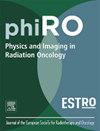Tumour nuclear size heterogeneity as a biomarker for post-radiotherapy outcomes in gynecological malignancies
IF 3.3
Q2 ONCOLOGY
引用次数: 0
Abstract
Background and Purpose:
Radiotherapy targets DNA in cancer cell nuclei. Radiation dose, however, is prescribed to a macroscopic target volume assuming uniform distribution, failing to consider microscopic variations in dose absorbed by individual nuclei. This study investigated a potential link between pre-treatment tumour nuclear size distributions and post-radiotherapy outcomes in gynecological squamous cell carcinoma (SCC).
Materials and Methods:
Our multi-institutional cohort consisted of 191 non-metastatic gynecological SCC patients who had received radiotherapy with diagnostic whole slide images (WSIs) available. Tumour nuclear size distribution mean and standard deviation were extracted from WSIs using deep learning, and used to predict progression-free interval (PFI) and overall survival (OS) in multivariate Cox proportional hazards (CoxPH) analysis adjusted for age and clinical stage.
Results:
Multivariate CoxPH analysis revealed that a larger nuclear size distribution mean results in more favorable outcomes for PFI (HR = 0.45, 95% CI: 0.19 - 1.09, p = 0.084) and OS (HR = 0.55, 95% CI: 0.24 - 1.25, p = 0.16), and that a larger nuclear size standard deviation results in less favorable outcomes for PFI (HR = 7.52, 95% CI: 1.43 - 39.52, p = 0.023) and OS (HR = 4.67, 95% CI: 0.96 - 22.57, p = 0.063). The bootstrap-validated C-statistic was 0.56 for PFI and 0.57 for OS.
Conclusion:
Despite low accuracy, tumour nuclear size heterogeneity aided prognostication over standard clinical variables and was associated with outcomes following radiotherapy in gynecological SCC. This highlights the potential importance of personalized multiscale dosimetry and warrants further large-scale pan-cancer studies.
肿瘤核大小异质性作为妇科恶性肿瘤放疗后预后的生物标志物
背景与目的:放疗靶向肿瘤细胞核中的DNA。然而,辐射剂量是按照宏观目标体积规定的,假设均匀分布,而没有考虑单个核吸收剂量的微观变化。本研究探讨了妇科鳞状细胞癌(SCC)治疗前肿瘤核大小分布与放疗后预后之间的潜在联系。材料和方法:我们的多机构队列包括191例接受放射治疗的非转移性妇科SCC患者,并提供诊断性全片图像(WSIs)。使用深度学习从wsi中提取肿瘤核大小分布平均值和标准差,并用于预测年龄和临床分期调整的多变量Cox比例风险(Cox proportional hazards, Cox)分析中的无进展间隔(PFI)和总生存期(OS)。结果:多元CoxPH分析表明一个更大的更有利的结果中核大小分布意味着结果PFI (HR = 0.45, 95%置信区间CI: 0.19 - 1.09, p = 0.084)和操作系统(HR = 0.55, 95%置信区间CI: 0.24 - 1.25, p = 0.16),和一个更大的核大小标准偏差导致不利于结果PFI (HR = 7.52, 95%置信区间CI: 1.43 - 39.52, p = 0.023)和操作系统(HR = 4.67, 95%置信区间CI: 0.96 - 22.57, p = 0.063)。启动验证的c统计量PFI为0.56,OS为0.57。结论:尽管准确性较低,但肿瘤核大小的异质性有助于标准临床变量的预后,并与妇科SCC放疗后的预后相关。这突出了个性化多尺度剂量测定的潜在重要性,并为进一步大规模的泛癌症研究提供了依据。
本文章由计算机程序翻译,如有差异,请以英文原文为准。
求助全文
约1分钟内获得全文
求助全文
来源期刊

Physics and Imaging in Radiation Oncology
Physics and Astronomy-Radiation
CiteScore
5.30
自引率
18.90%
发文量
93
审稿时长
6 weeks
 求助内容:
求助内容: 应助结果提醒方式:
应助结果提醒方式:


